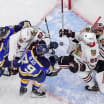NHL.com will identify NHL EDGE stats that translate to fantasy hockey all season long. For more fantasy coverage, visit NHL.com/Fantasy.
---
MORE FANTASY COVERAGE:
Top 200 rankings | Projected lineups
SUBSCRIBE: NHL Fantasy on Ice podcast 🎧
---
Blues’ power play outlook under new coach
The St. Louis Blues became the third NHL team to make a coaching change this season (others: Edmonton Oilers, Minnesota Wild) when they replaced Craig Berube with Drew Bannister on Tuesday. The Blues won their first game after the move, a 4-2 victory against the Ottawa Senators on Thursday.
The Blues power play ranks last in the NHL (8.1 percent) after going 0-for-3 on Thursday but has plenty of bounce-back potential based on advanced metrics. Per NHL EDGE stats, St. Louis has the fifth-best offensive zone time percentage on the power play (62.4) behind only the New York Rangers (65.6), Edmonton Oilers (63.0), Florida Panthers (62.9) and Vancouver Canucks (62.9).
St. Louis has one of the NHL’s best 5-on-5 point producers in forward Robert Thomas, who’s tied for fifth in the League in even-strength points (25 in 29 games), and one of the breakout goal scorers over the past month in Jake Neighbours (eight goals in 15 games since Nov. 15; tied for seventh in League). But forward Jordan Kyrou, who led the Blues in goals (37), points (73 in 79 games), power-play points (23) and shots on goal (272) last season, has taken a step back this season (18 points, four on power play, in 29 games). No one on the Blues has more than four power-play points.
That said, Kyrou could rebound under Bannister considering the forward had an assist and four shots on goal Thursday and has the third-lowest shooting percentage (5.4) in the NHL among those with at least 75 shots on goal (leads Blues with 93) behind Matthew Tkachuk (4.7) of the Panthers and Alex Ovechkin (5.3) of the Washington Capitals.
Kyrou has seen time on the second power play this season but is at least back on the top line with Thomas and wing Pavel Buchnevich (leads St. Louis with 1.02 points per game since 2021-22; 166 points in 163 games) – making Kyrou a buy-low trade target in fantasy.
Islanders offense finding new gear
The New York Islanders were known as a defensive team in their four seasons under Barry Trotz (2018-19 to 2021-22) and even over the past two seasons under his protege Lane Lambert. But this season has taken a drastically different turn; the Islanders are allowing the second-most shots on goal per game (35.5) in the NHL, but, over the past month, rank third in the League in goals per game (3.79 since Nov. 15).
New York’s suddenly potent offense has two point-per-game players in forward Mathew Barzal (30 in 27 games) and defenseman Noah Dobson (29 in 28). To put that in context, the Islanders’ last player with a point per game or better was Barzal as a rookie in 2017-18 (NHL career-high 85 points), so the change in style has unlocked the fantasy ceilings of their best players.
The Islanders’ goalie tandem of Ilya Sorokin and Semyon Varlamov has remained formidable, ranking fifth in the NHL in team save percentage (.912) despite dealing with much more of a barrage than previous seasons. And a huge reason for New York’s offensive resurgence is the top line of Barzal, center Bo Horvat (26 points in 27 games) and wing Anders Lee. Barzal shifted from center to wing after the Islanders acquired Horvat last season and, when healthy, has been an elite scorer again.
Per NHL EDGE stats, Barzal is tied for fourth in the entire NHL in mid-range goals (seven; 99th percentile) scored on 28 mid-range shots on goal (94th percentile), Lee is tied for sixth in the entire League in high-danger shots on goal (42; 99th percentile) and Horvat has excelled in mid-range shots on goal (28; 94th percentile).
An important element driving this line’s success is the speed of Barzal and Horvat, and their advanced metrics reflect that strength relative to the rest of the NHL. Barzal ranks ninth in the entire NHL in speed bursts of at least 20 mph (115). Barzal (98th percentile) and Horvat (95th) are among the League's best in speed bursts of 20-22 mph.
Barzal’s position change has meant he hasn’t had to take nearly as many face-offs against top-line centers, allowing him to roam the ice more freely – as evidenced by his NHL EDGE skating distance (87.33 miles; 91st percentile; league average among forwards: 51.72) – and play to his strengths again.
Canadiens' Matheson earns longest single-game skating distance of season
Per NHL EDGE stats, Montreal Canadiens defenseman Mike Matheson reached the longest single-game skating distance of any player this season when he covered 4.71 miles against the Pittsburgh Penguins on Wednesday. Matheson ranks fourth among all NHL skaters in total skating distance (106.30 miles) this season.
Matheson, who is ranked 16th among NHL defensemen in standard fantasy leagues this season, has nearly the same points-per-game average (0.69; 20 in 29 games) as he did last season (0.71) and is on pace for an NHL career-high 57 points if he plays all 82 games. He ranks sixth in the NHL in average ice time (25:17).
Matheson is also an NHL EDGE stat standout considering he ranks among the League's top 10 defensemen in high-danger shots on goal (seven; seventh), mid-range SOG (18; tied for seventh) and long-range SOG (35; 10th).


















